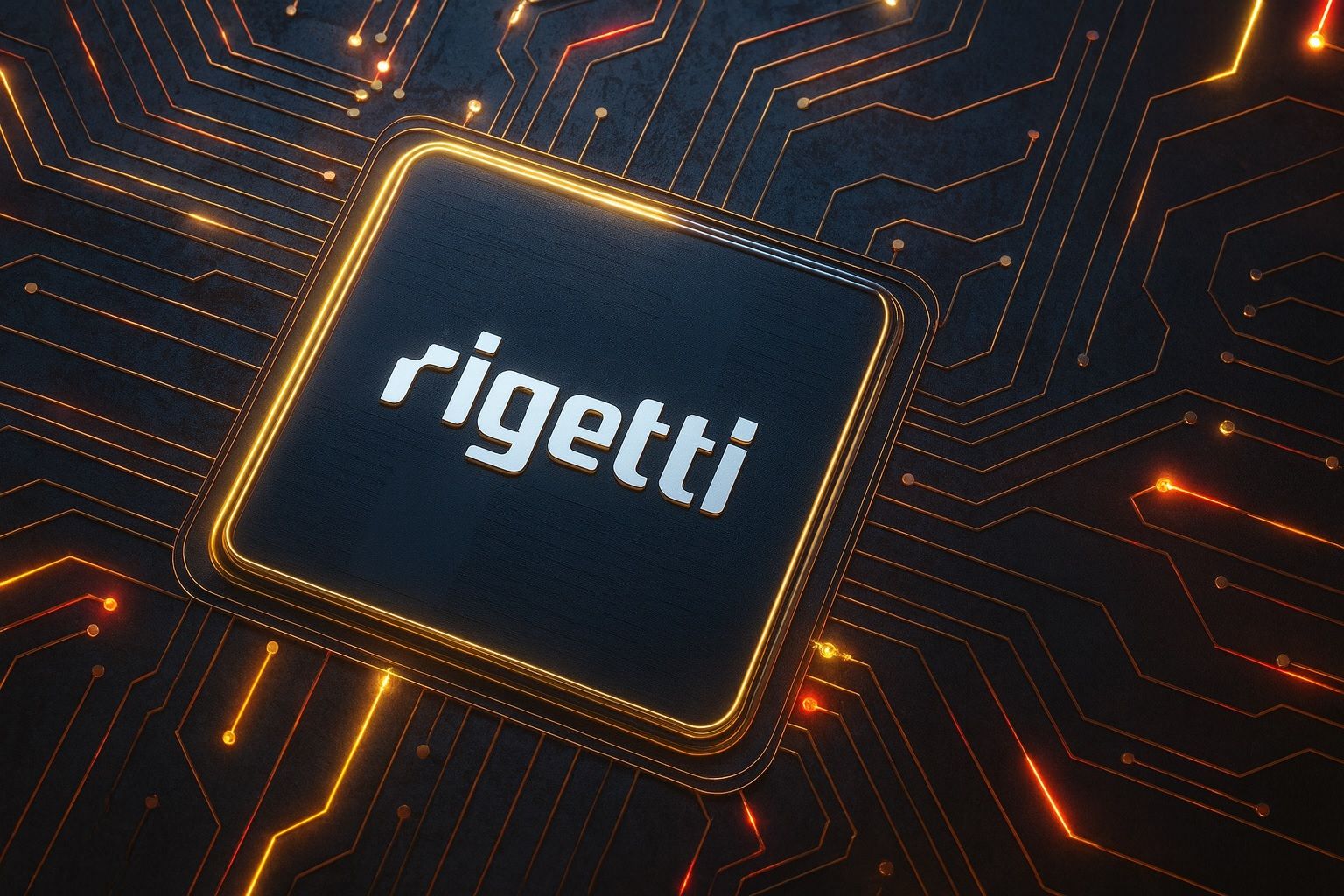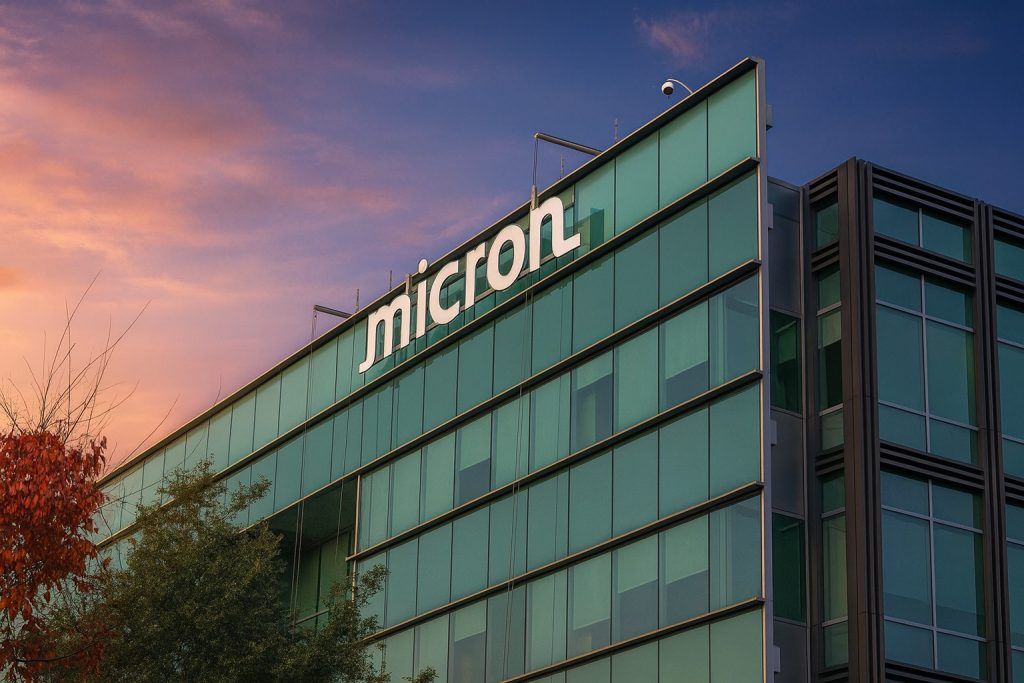- Wild price swings: Rigetti Computing (NASDAQ: RGTI) hovered around $48 per share on Oct. 17 after a roller-coaster week that saw new highs followed by a 15% plunge [1].
- Year-long surge: RGTI is up over 5,000% year-over-year [2] amid a quantum computing stock boom, but it gave back gains this week as analysts warn of overvaluation and “quantum hype” [3].
- Big bank boost: JPMorgan’s plan to invest $10 billion in strategic industries (including quantum) fueled an early-week rally [4]; Rigetti and peers like IonQ and D-Wave jumped on the news before pulling back on profit-taking.
- Recent milestones: Rigetti announced new contracts in late September (a $5.7 M order for its Novera quantum systems and a $5.8 M U.S. Air Force project) and unveiled a 36-qubit “Cepheus” processor [5], stoking excitement despite minimal current revenues.
- Analysts divided: Wall Street is bullish long-term (all 6 covering analysts rate RGTI a Buy [6]), but most 12-month price targets (~$20–$24) sit far below the recent stock price [7] – a reality-check on near-term valuation.
- Hype vs. reality: Market pundits urge caution – CNBC’s Jim Cramer calls Rigetti a mere “speculation” at these levels [8] – yet the company’s hefty cash reserves and rapid tech progress keep quantum bulls optimistic.
RGTI Stock’s Roller-Coaster Week
Rigetti’s stock enjoyed a meteoric rise early in the week, then suffered a sharp reversal. Shares of RGTI surged to fresh highs around $58 – the upper end of its 52-week range [9] – before tumbling roughly 15% in a single day on Thursday, Oct. 16 [10]. The sell-off dropped the stock to the high-$40s, trimming its weekly gains. Rigetti wasn’t alone: other quantum computing darlings like IonQ and D-Wave Quantum also sank ~9% on Thursday amid a broad pullback [11]. Traders appear to have cashed in profits after a torrid run, as concerns mounted that these stocks had run “far ahead of fundamentals” [12].
The week’s volatility was sparked by contrasting forces. On the bullish side, a major announcement from JPMorgan Chase ignited enthusiasm. The banking giant revealed plans to pour $10 billion into companies deemed vital to U.S. economic security – explicitly calling out quantum computing as a target sector [13] [14]. This news sent quantum stocks higher: by Thursday midday, RGTI was up nearly 10% for the week on the JPMorgan boost [15]. However, by late week the euphoria met reality. Reports emerged that sector leaders might capitalize on sky-high valuations by issuing more shares – for example, IonQ’s stock dipped ~6% after it unveiled a $1 billion share sale plan [16]. Combined with growing chatter about a “quantum bubble,” this triggered a wave of profit-taking in Rigetti and its peers. “Rigetti Computing faces [a] sharp sell-off as analysts warn of ‘quantum hype,’” one Yahoo Finance piece noted pointedly [17]. In short, the stock went from hot to cold in a matter of days, as short-term traders reacted to both hype and warnings.
Quantum Computing Boom Lifts Rigetti
This wild week comes in the context of an astonishing year for Rigetti. Just a year ago, RGTI was a penny stock trading under $1. Since then it has skyrocketed roughly 55-fold (a +5,595% one-year return) [18], making Rigetti one of 2025’s top-performing stocks. Its market capitalization ballooned to around $15 billion [19] – an eye-popping figure for a company with only single-digit millions in annual revenue. Rigetti is often called a “quantum computing pure-play,” one of just a few publicly traded firms focused solely on quantum tech (others include IonQ, D-Wave, and Quantum Computing Inc.). All have seen spectacular rallies in 2025 on optimism about the field’s potential, despite minimal revenue bases [20]. As Barron’s observed, a basket of these quantum stocks has jumped nearly fourfold on average in a year even though they “generate relatively little revenue” [21]. In other words, investors have been betting on the future promise of quantum computing, not its present profits.
Rigetti’s recent news announcements helped fuel this speculative fervor. In late September, the company unveiled a new 36-qubit quantum processor dubbed “Cepheus”, featuring a multi-chip architecture and 99.5% two-qubit fidelity (a measure of performance) [22]. It also announced several notable deals: roughly $5.7 million in new orders for its Novera quantum computing systems (designed as small, on-premises quantum units for labs) and a $5.8 million contract with the U.S. Air Force’s research lab to develop quantum networking technology [23]. Additionally, Rigetti entered a $100+ million collaboration with Quanta Computer (including a $35 M equity investment by Quanta) and signed a partnership MOU with India’s government-backed C-DAC to co-develop quantum-classical computing solutions [24].
While these contract values are modest, they represented real customer demand and technical progress – enough to repeatedly spark double-digit stock jumps. “These ‘headline’ developments, although modest in revenue, [have] repeatedly fueled double-digit stock jumps as investors seized on any sign of progress,” TechStock² observed [25]. In the words of Rigetti’s CEO Dr. Subodh Kulkarni, the new orders show that the Novera platform “continues to be chosen and trusted” by organizations worldwide as interest in on-premises quantum computers rises [26]. For many investors, such deals and product milestones signal that Rigetti is at the forefront of a potentially revolutionary industry. The company is racing to scale up its technology – it has reaffirmed plans to deliver a 100+ qubit system by the end of 2025 [27] – and its innovations have put it on the map alongside much larger players. (Notably, tech giants like IBM, Google, and Microsoft are also heavily invested in quantum R&D, but those conglomerates don’t offer pure-play stock exposure to quantum computing [28].)
However, hype and reality are diverging when it comes to financials. Rigetti remains an early-stage company with very limited revenue. For the full year 2024, it recorded only $10.8 million in revenue against a net loss of roughly $201 million [29]. In the most recent quarter (Q2 2025), revenue was a mere $1.8 million while the net loss totaled $39.7 million [30]. In other words, Rigetti is still burning cash to develop its technology, with negligible sales so far. Even with the new contracts signed, analysts forecast 2025 full-year revenue around $8–9 million, rising to ~$20 million in 2026 [31] – huge growth in percentage terms, but tiny in absolute dollars considering the company’s multi-billion valuation. The stock’s breathtaking rise has far outpaced these fundamentals. As one analysis noted, Rigetti’s valuation metrics are stratospheric: at recent prices it traded around 981× sales (P/S) and 28× book value (P/B), compared to roughly 3–4× for typical tech stocks [32]. In fact, Rigetti has no positive earnings yet (its P/E is negative), so investors are essentially pricing in years of future growth. This dynamic underscores why the stock is so volatile – it “trades on future potential” and any signal can swing sentiment dramatically [33].
Hype Meets Reality: What Analysts Say
Wall Street analysts covering Rigetti are in a somewhat awkward position: they largely believe in the company’s long-term prospects, yet many have been caught off-guard by the stock’s extreme rally. According to TipRanks and other sources, all six or seven analysts who officially cover RGTI stock rate it a Buy or Strong Buy, reflecting optimism about Rigetti’s technology and market opportunity [34]. However, their price targets tell a different story. The average 12-month target price is only in the $20–24 range [35], which is roughly 50% below where the stock traded even after this week’s pullback. Most analyst targets are in the teens to low-$20s (for example, Needham & Co. recently reiterated a Buy rating with an ~$18 target [36]). Only a couple of outliers have dared to chase the stock upwards: Benchmark Capital raised its target to $50 (Buy) earlier this month, and B. Riley analyst Craig Ellis boosted his target from $19 to $35 in late September [37]. Even those bullish exceptions remain below Rigetti’s peak price. This disparity between bullish ratings and cautious price targets suggests that analysts see tremendous long-term potential in Rigetti, but also feel the current valuation is hard to justify based on near-term fundamentals [38].
Some research firms have even taken a contrarian stance amid the frenzy. Notably, independent ratings firm Weiss issued a rare “Sell” rating on RGTI in early October [39], citing concerns that the stock’s parabolic rise was out of line with reality. And financial commentators have been sounding alarms. CNBC’s Jim Cramer weighed in on the hype, remarking “I don’t know whether Rigetti is worth what Rigetti is trading at,” bluntly labeling the stock a “speculation” rather than an investment [40]. Another analyst quipped that Rigetti is like a “lottery ticket” – extremely high-risk, albeit with potentially high reward if quantum tech lives up to its promise [41]. These warnings underscore a growing sentiment that, while Rigetti’s technology is exciting, its stock may have run too far, too fast for its own good.
On the other hand, quantum bulls argue that such skepticism is short-sighted. They point to the enormous market opportunity in quantum computing over the coming decade. By one estimate, quantum technologies could unlock $1 trillion in economic value by 2035 [42] through advances in computing power, optimization, cryptography, and materials science. From that perspective, a $15 billion valuation might ultimately prove justified (or even cheap) if Rigetti secures a meaningful slice of a trillion-dollar industry. Supporters also note that Rigetti is in a relatively strong financial position for a startup. The company took advantage of its surging stock price earlier in 2025 to raise capital – roughly $350 million in Q2 via an ATM stock offering – leaving it with a cash war chest of about $572 million and no debt as of mid-2025 [43]. This liquidity provides a runway for several years of R&D and growth, reducing the pressure to dilute shareholders again immediately. (In contrast, some competitors have had to raise funds more aggressively; e.g., smaller rival Quantum Computing Inc. recently sold $500 million in new shares to bolster its cash reserves [44].) With cash in hand, Rigetti can focus on technical milestones – such as achieving its 100-qubit goal – without returning to the capital markets in the very near term.
Several analysts also highlight positive developments underpinning Rigetti’s story. B. Riley’s Craig Ellis, for instance, cited Rigetti’s “rapid tech breakthroughs” in raising his price target [45]. Needham’s Quinn Bolton has emphasized the significance of Rigetti’s 36-qubit chip and its roadmap to 100+ qubits, viewing these as validation of the company’s engineering approach [46]. And Zacks Equity Research noted Rigetti’s improved quantum processor fidelity and strong cash position as bullish factors, even as it questioned how long the 264% year-to-date rally could hold without concrete revenue growth [47] [48]. In essence, the bull case is that Rigetti is successfully executing on technology and has shored up its finances, positioning it well to ride the quantum wave – provided that wave doesn’t crash due to overinflated expectations.
Outlook: High Reward, High Risk
Looking ahead, Rigetti Computing sits at a crossroads between immense promise and intense scrutiny. The company’s next big milestones – including the planned debut of a >100-qubit quantum computer by year-end and the forthcoming Q3 2025 earnings report (expected in the next few weeks) – could be pivotal. Positive news, like hitting a technology benchmark or signing a major commercial client, might reignite the stock’s momentum. There is no doubt that interest in quantum computing is surging worldwide, from government agencies to large enterprises, and Rigetti has positioned itself as a key player in this nascent industry. The strategic partnerships with organizations like NASA/Air Force, leading tech firms (Quanta), and international bodies (India’s C-DAC) underscore that Rigetti is on the radar for high-profile initiatives. If the company continues to demonstrate progress – say, improving quantum performance or scaling up its customer base – investors could very well pile back in, betting that today’s lofty valuation will be earned out by tomorrow’s growth.
At the same time, risks abound. The recent pullback serves as a reminder that gravity applies, even to rockets. A stock that multiplies 50× in a year can just as easily swing wildly or correct further. Any hiccup – such as delays in Rigetti’s technology roadmap, disappointing financial results, or a broader market shift away from speculative tech – could trigger further declines. Moreover, the dilution question will linger in investors’ minds. Rigetti’s peers have shown that when stock prices soar, quantum startups often seize the opportunity to raise capital (diluting existing shareholders). While Rigetti’s cash position is strong for now, if it decided to accelerate expansion or if R&D expenses grow, the temptation to tap equity markets again will be there. Even simply maintaining its current spending, Rigetti is forecast to lose tens of millions per quarter for the foreseeable future [49] – a burn rate that will eventually require additional funding unless revenue ramps up dramatically.
In summary, Rigetti’s stock embodies the high-risk, high-reward nature of quantum computing investing. The company is a leader in a field that could transform computing and create enormous value in the long run. Yet in the short run, its stock has become a speculative battleground between believers and skeptics. As one analyst put it, “lottery ticket” stocks like RGTI can swing on sentiment as much as substance [50]. This week’s whipsaw trading showed both sides of that coin – euphoria early, anxiety late. For investors and observers, the key question is whether Rigetti can start delivering results that bridge the gap between hype and reality. The coming months will be telling. Rigetti’s ability to execute on its technology, grow its customer base, and justify its valuation will determine if the stock’s quantum leap leads to sustained success or a sobering comedown. In the meantime, one thing is guaranteed: volatility. Quantum computing may be complex, but with Rigetti’s stock, the narrative is simple – big dreams, big risks, and a market waiting to see if this quantum pioneer can turn its bold promises into tangible progress for shareholders.
Sources: Rigetti press releases and financial filings; TechStock² (TS2.tech) analysis [51] [52] [53] [54]; Yahoo Finance/Motley Fool reports [55] [56]; MarketBeat and Zacks data [57] [58]; CNBC commentary [59].
References
1. finviz.com, 2. finviz.com, 3. swingtradebot.com, 4. www.mitrade.com, 5. ts2.tech, 6. ts2.tech, 7. ts2.tech, 8. ts2.tech, 9. www.marketbeat.com, 10. finviz.com, 11. swingtradebot.com, 12. swingtradebot.com, 13. www.mitrade.com, 14. www.mitrade.com, 15. www.mitrade.com, 16. swingtradebot.com, 17. swingtradebot.com, 18. finviz.com, 19. www.marketbeat.com, 20. ts2.tech, 21. ts2.tech, 22. ts2.tech, 23. ts2.tech, 24. ts2.tech, 25. ts2.tech, 26. ts2.tech, 27. ts2.tech, 28. ts2.tech, 29. ts2.tech, 30. ts2.tech, 31. ts2.tech, 32. ts2.tech, 33. ts2.tech, 34. ts2.tech, 35. ts2.tech, 36. ts2.tech, 37. ts2.tech, 38. ts2.tech, 39. www.marketbeat.com, 40. ts2.tech, 41. ts2.tech, 42. proinvestor.com, 43. ts2.tech, 44. ts2.tech, 45. ts2.tech, 46. ts2.tech, 47. ts2.tech, 48. ts2.tech, 49. ts2.tech, 50. ts2.tech, 51. ts2.tech, 52. ts2.tech, 53. ts2.tech, 54. ts2.tech, 55. www.mitrade.com, 56. swingtradebot.com, 57. www.marketbeat.com, 58. finviz.com, 59. ts2.tech







